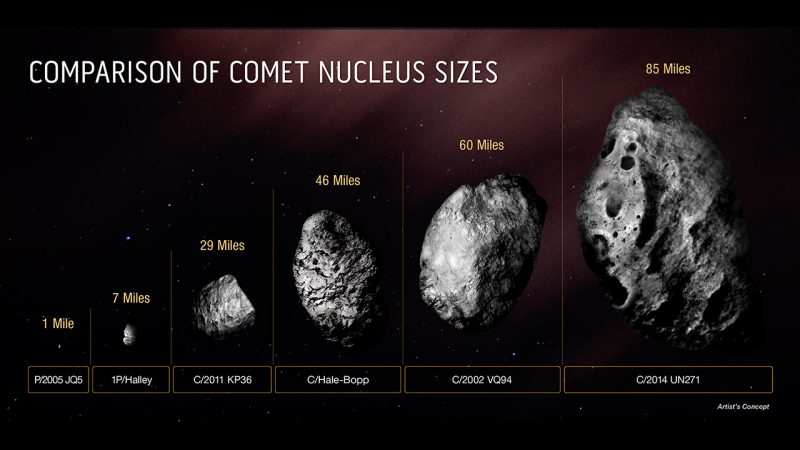
Scientists announced on April 12, 2022, that they’ve created a high-quality image confirming C/2014 UN271 (Bernardinelli-Bernstein), affectionately known as BB, is the largest Oort Cloud comet yet discovered. The new comet’s nucleus, or core, is about 75 miles (120 km) wide, or about twice the size of Comet Hale-Bopp, which put on such a good show for us in 1997. And BB is headed for the inner regions of the solar system now.
The good news is NASA says it’ll come nowhere near Earth. From NASA’s official announcement:
The behemoth comet, C/2014 UN271 (Bernardinelli-Bernstein) is barreling this way at 22,000 miles per hour (35,400 kph), from the edge of the solar system. But not to worry. It will never get closer than 1 billion miles away from the sun, which is slightly farther than the distance of the planet Saturn. And that won’t be until the year 2031.
The team behind the study published their results on April 10, 2022, in the peer-reviewed Astrophysical Journal Letters.
Discovery of the biggest comet yet
University of Pennsylvania astronomers Pedro Bernardinelli and Gary Bernstein discovered the comet. They were reviewing images from 2014 to 2018 from the Dark Energy Survey as part of their computer-aided search for trans-Neptunian objects.

So how big is it?
At the time of the initial discovery, scientists estimated the comet’s icy, dusty core at 62 to 230 miles (100 to 370 km) wide. The new imagery refines the estimate to a range between 66 and 86 miles (105 to 140 km), making it roughly twice the size of Comet Hale-Bopp. Comet Hale-Bopp appeared as a naked-eye object in 1997 and thrilled observers around the world. The previous record holder for the largest comet nucleus was C/2002 VQ94 (LINEAR), which measures about 60 miles (100 km) at its widest.
The new big kid on the cosmic block is far from alone, said David Jewitt, professor of planetary science and astronomy at UCLA and co-author of the study that refined the comet’s measurements. From NASA’s announcement:
This comet is literally the tip of the iceberg for many thousands of comets that are too faint to see in the more distant parts of the solar system. We’ve always suspected this comet had to be big because it is so bright at such a large distance. Now we confirm it is.
The biggest comet yet is getting closer
While the discovery of Comet BB came in 2014, its first appearance on image data was in 2010. At that time, BB was 3 billion miles (4.8 billion km) from Earth, coincidentally about the average distance to Neptune. Now, the object is about a billion miles closer, yet still well out in the outer reaches of the solar system.
Already the core is shedding gas and dust at an impressive rate of about 2,200 pounds (1,000 kg) a second. The authors of the paper described it as:
… an enormous (albeit uncertain) mass-loss rate.
It was that voluminous outpouring of gas and dust coming from a body so distant in the solar system that prompted the research team to try measuring what they suspected was a huge cometary body. Man-To Hui of the Macau University of Science and Technology, Taipa, Macau, led the team. Hui said:
This is an amazing object, given how active it is when it’s still so far from the sun. We guessed the comet might be pretty big, but we needed the best data to confirm this.
Obtaining images of Comet BB
To gather that data, Hui’s team used the Hubble Space Telescope’s Wide Field Camera 3 to take five photos of the comet on January 8, 2022.
In announcing the team’s find, NASA described the process team members used to discern the size of the nucleus against the backdrop of the glare of the comet’s coma and tails:
The comet is currently too far away for its nucleus to be visually resolved by Hubble. Instead, the Hubble data show a bright spike of light at the nucleus’ location. Hui and his team next made a computer model of the surrounding coma and adjusted it to fit the Hubble images. Then, the glow of the coma was subtracted to leave behind the starlike nucleus.
By combining the Hubble data set with radio observations made by the Atacama Large Millimeter/Submillimeter Array (ALMA) in Chile, the team was able to assign upper and lower limits to the size of C/2014 UN271.
The team also found the comet is less reflective than originally thought. According to Jewitt:
It’s big and it’s blacker than coal.
Bottom line: Comet C/2014 UN271, also known as Comet Bernardinelli-Bernstein or BB, is the biggest comet yet, as confirmed by new Hubble images. The comet is about twice the size of Comet Hale-Bopp, or around 75 miles (120 km) wide.
The post Biggest comet yet headed to inner solar system first appeared on EarthSky.
0 Commentaires